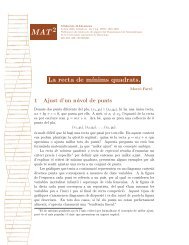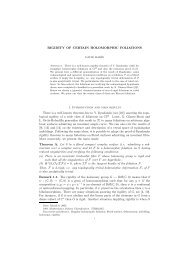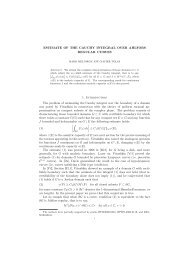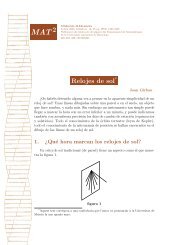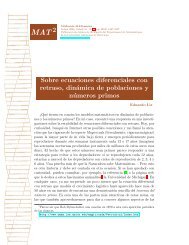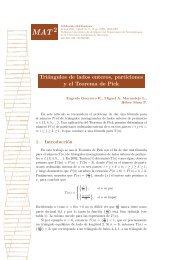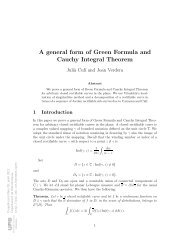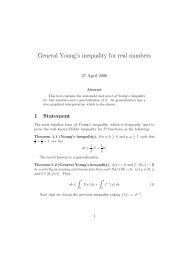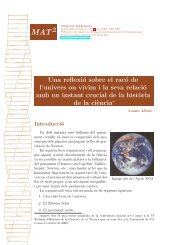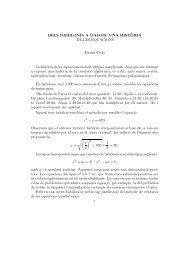ASPECTS OF IWASAWA THEORY OVER FUNCTION FIELDS 1 ...
ASPECTS OF IWASAWA THEORY OVER FUNCTION FIELDS 1 ...
ASPECTS OF IWASAWA THEORY OVER FUNCTION FIELDS 1 ...
Create successful ePaper yourself
Turn your PDF publications into a flip-book with our unique Google optimized e-Paper software.
since dlog (f ◦ g) = g ′ ( f ′fby (6.4),<strong>IWASAWA</strong> <strong>THEORY</strong> <strong>OVER</strong> <strong>FUNCTION</strong> <strong>FIELDS</strong> 25◦ g). Composing with e C and using Φ a (e C (x)) = e C (ax), one gets,(dlog Col σu )(e C (x)) = χ(σ)(dlog Col u )(e C (χ(σ)x)) = χ(σ)The result follows.6.4. Cyclotomic units.∞∑δ k (u)χ(σ) k−1 x k−1 .Definition 6.6. The group C n of cyclotomic units in F n is the intersection of B ∗ n with thesubgroup of F ∗ n generated by σ(ω n ), σ ∈ Gal(F n /F ).By the explicit description of the Galois action via Φ, one sees immediately that this is thesame as B ∗ n ∩ 〈Φ a (ω n )〉 a∈A−p .Lemma 6.7. Let ∑ c σ σ be an element in Z[Gal(F n /F )]: then∏σ(ω n ) cσ ∈ C n ⇐⇒ ∑ c σ = 0 .σ∈Gal(F n /F )Proof. Obvious from the observation that ω n is a uniformizer for the place above p and a unitat every other finite place of F n .□Let C n and C 1 n denote the closure respectively of C n ∩ O ∗ n and of C 1 n := C n ∩ U n .Let a ∈ A ∗ p. By Remark 6.3 (Φ a (ω n )) n is a norm compatible system: hence one can definea homomorphismΥ: Z[˜Γ] −→ lim K ∗←n∑cσ σ ↦→ ∏ (σ(ωn ) c ) σn = ∏ (Φχ(σ) (ω n ) c ) σnLet lim ̂ K ∗←n be the p-adic completion of lim K ∗←n. By (6.1) one gets the isomorphism lim ̂ K ∗←n ≃ω Z p× lim←U n .Lemma 6.8. The restriction of Υ to Z[Γ] can be extended to Υ: Λ → ̂ lim←K ∗ nProof. If a ∈ A p is a 1-unit, then(6.5) Φ a (ω n ) = ω n u nwith u n ∈ U n . Since by definition Γ = χ −1 (1 + πA p ), it follows that Υ sends Z[Γ] intoω Z × lim←U n . To complete the proof it suffices to check that Υ is continuous with respect tothe natural topologies on Λ = lim(Z/p n Z)[Gal(F n /F )] and lim ̂ K ∗← ←n. But a ≡ a ′ mod π n in A pimplies Φ a (ω j ) = Φ a ′(ω j ) for any j ≤ n; and the result follows from the continuity of χ. □Proposition 6.9. Let I ⊂ Λ denote the augmentation ideal: then Υ induces a surjectivehomomorphism of Λ-modules I −→ lim←C 1 n. The kernel has empty interior.Proof. From Lemma 6.7 and (6.5) it is clear that Υ(α) ∈ lim←C 1 n if and only if α ∈ I. Thismap is surjective because I is compact and already the restriction to the augmentation idealof Z[Γ] is onto Cn 1 for all n. A straightforward computation shows that it is a homomorphismof Λ-algebras: for γ ∈ Γ(∑ ) ( (∏ ) ) (∏ )(6.6) γΥ cσ σ = γ Φχ(σ) (ω n ) c σ= Φχ(σγ) (ω n ) c σnnbecause γ(Φ a (ω n )) = Φ a (γ(ω n )) = Φ a (Φ χ(γ) (ω n )).k=1□



